Not every corner of your home gets flooded with natural light, but that doesn’t mean these spaces can’t be filled with lush, thriving greenery.
Low-light houseplants are the secret weapon in home decor that can transform even the darkest corners into vibrant living spaces.
These resilient plants have adapted to survive and even thrive in shadowy conditions, making them perfect for north-facing windows, hallways without natural light, or those tricky spots far from windows.
The right low-light houseplant not only brings nature indoors but also purifies your air and creates a calming atmosphere.
With their varied textures, shapes, and subtle color variations, these plants add visual interest to spaces that might otherwise feel dull or forgotten.
1. Snake Plants: The Ultimate Survivalist
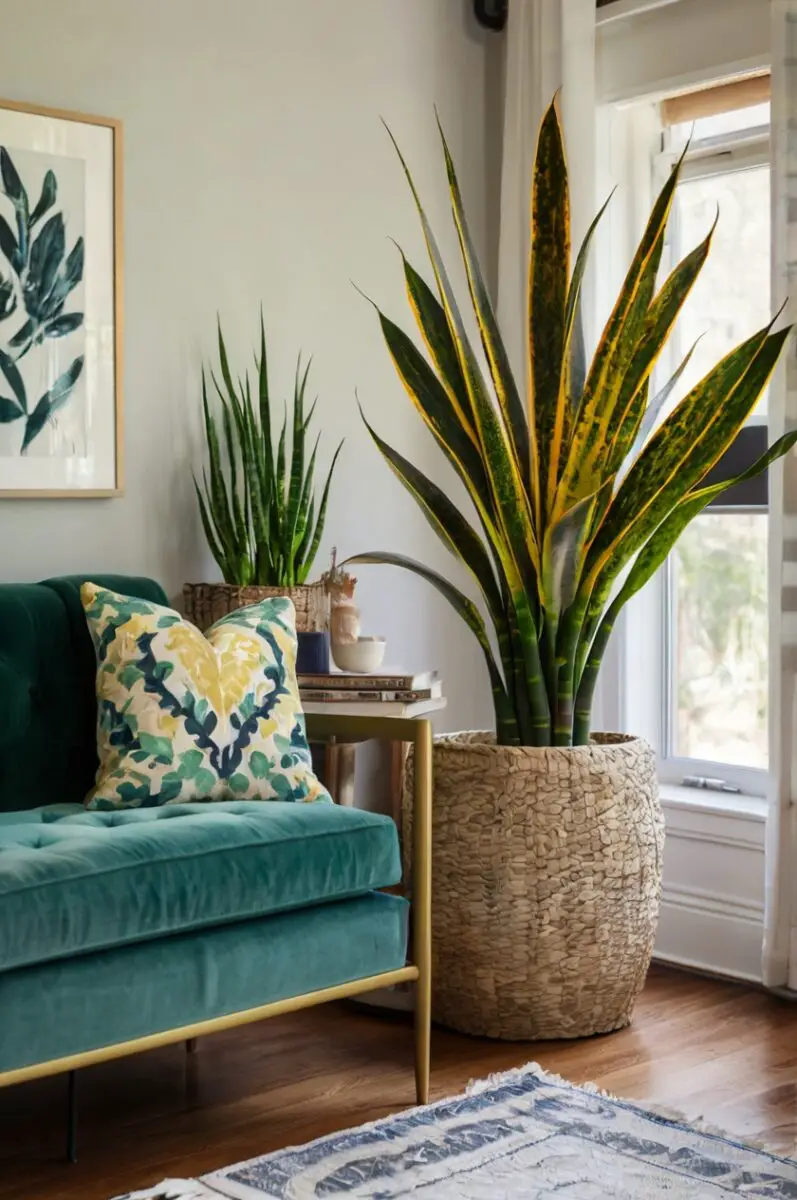

Snake plants (Sansevieria) are the undisputed champions of low-light environments.
These architectural beauties feature tall, sword-like leaves with striking patterns that stand upright, commanding attention even in the darkest corners.
Their structural form makes them perfect statement pieces in modern, minimalist spaces.
Snake plants come in various sizes, from dwarf varieties perfect for desktops to impressive floor specimens that can reach several feet tall.
The contrasting yellow edges found on some varieties add a pop of brightness to dark areas without needing much light to maintain their vibrant appearance.
Place your snake plant in a sleek, cylindrical pot to enhance its modern appeal.
For an elevated look, consider grouping three snake plants of varying heights to create a striking visual display.
These plants thrive when slightly neglected, requiring watering only when the soil is completely dry.
The vertical growth pattern makes snake plants ideal for narrow spaces like the gap between furniture or that awkward corner in your hallway.
Try placing a snake plant on a plant stand of contrasting material – a terracotta pot on a black metal stand, for example – to create visual interest through texture variation.
Snake plants also make excellent bedroom companions as they release oxygen at night, unlike most plants which only do so during daylight hours.
Consider creating a mini snake plant sanctuary by grouping different varieties together, showcasing their subtle differences in pattern and color.
For a dramatic effect, place a single tall snake plant in a dark corner with a small uplight behind it, creating fascinating shadows on nearby walls.
Madison’s Current Obsessions
Beautiful Home Decor Brands Similar to Rifle Paper Co You Need to Know2. ZZ Plants: Glossy Glamour in Shadows
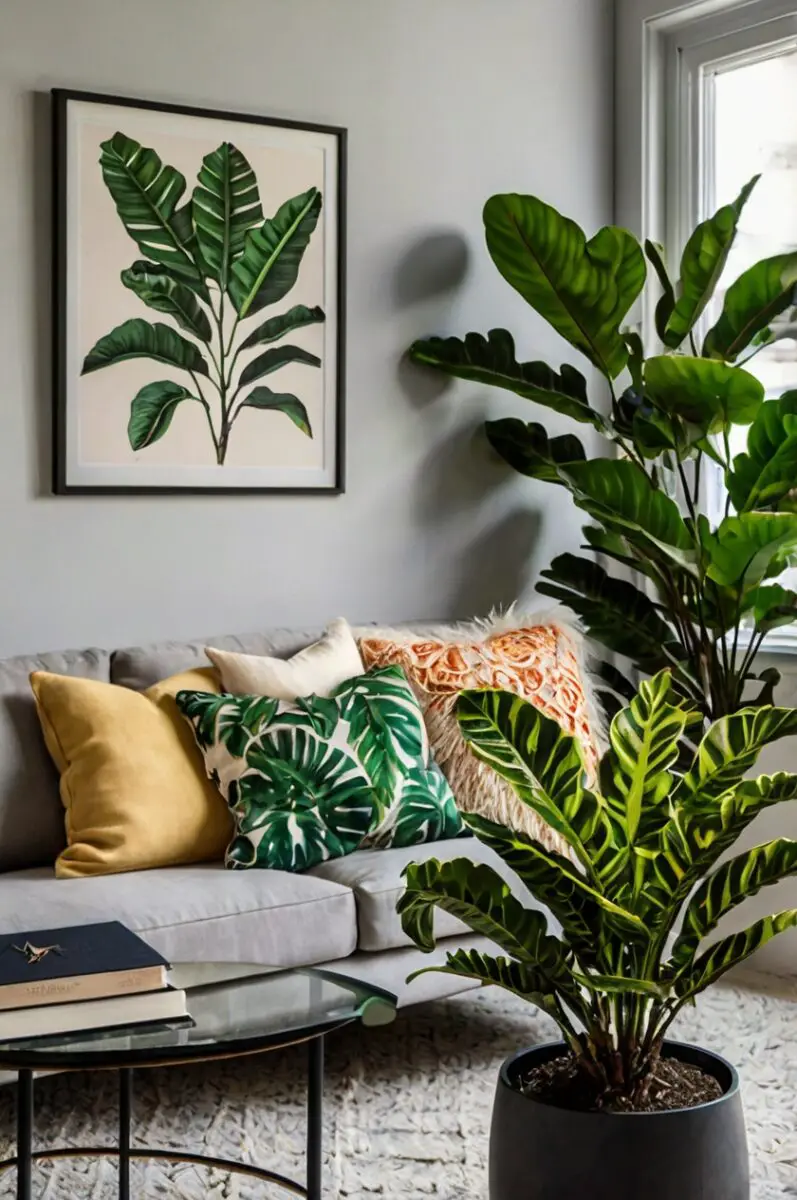
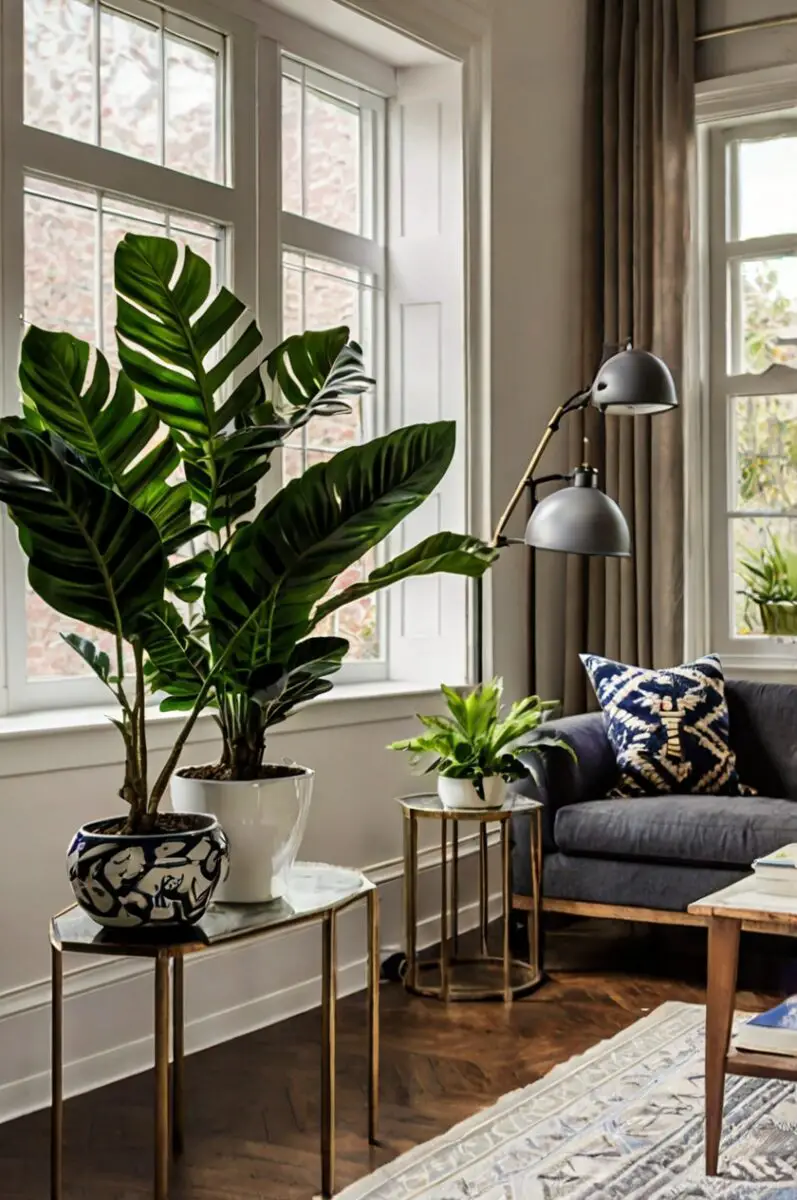
ZZ plants (Zamioculcas zamiifolia) feature glossy, dark green leaves that seem to glow even in low-light conditions.
These plants have an elegant, arching growth pattern that adds sophisticated movement to any space.
The mirror-like quality of their leaves reflects what little light is available, making them appear luminous in dark corners.
ZZ plants grow from bulbous rhizomes that store water, making them incredibly drought-tolerant and perfect for forgetful waterers.
Their naturally symmetrical growth creates a balanced, harmonious appearance that works beautifully in contemporary living spaces.
For a dramatic display, place your ZZ plant in a white ceramic pot against a dark wall to emphasize its sculptural quality.
ZZ plants pair beautifully with metallic accents, so consider placing one near brass or copper decorative elements for a luxe vibe.
The plant’s slow growth means it won’t quickly outgrow its space, making it ideal for careful compositions that you want to maintain.
Try elevating your ZZ plant on a small side table in a dark hallway to create a welcoming moment where light is scarce.
For maximum impact, choose a pot that contrasts with the deep green leaves – matte black, soft terracotta, or even a jewel-toned glazed pot all work beautifully.
ZZ plants can be divided when they grow larger, giving you free plants to spread throughout your home or share with friends.
Consider creating a vignette with your ZZ plant by pairing it with a stack of books and a small lamp to create a cozy reading nook in a dim corner.
The glossy leaves can be gently wiped clean to maintain their shine, keeping your plant looking picture-perfect with minimal effort.
Design Your Dream Room in Minutes! By DreamyHomeStyle
🏡 Start Creating FREE →Madison’s Current Obsessions
13 Magical Decor Ideas for a Whimsical Home3. Pothos: Cascading Curtains of Green
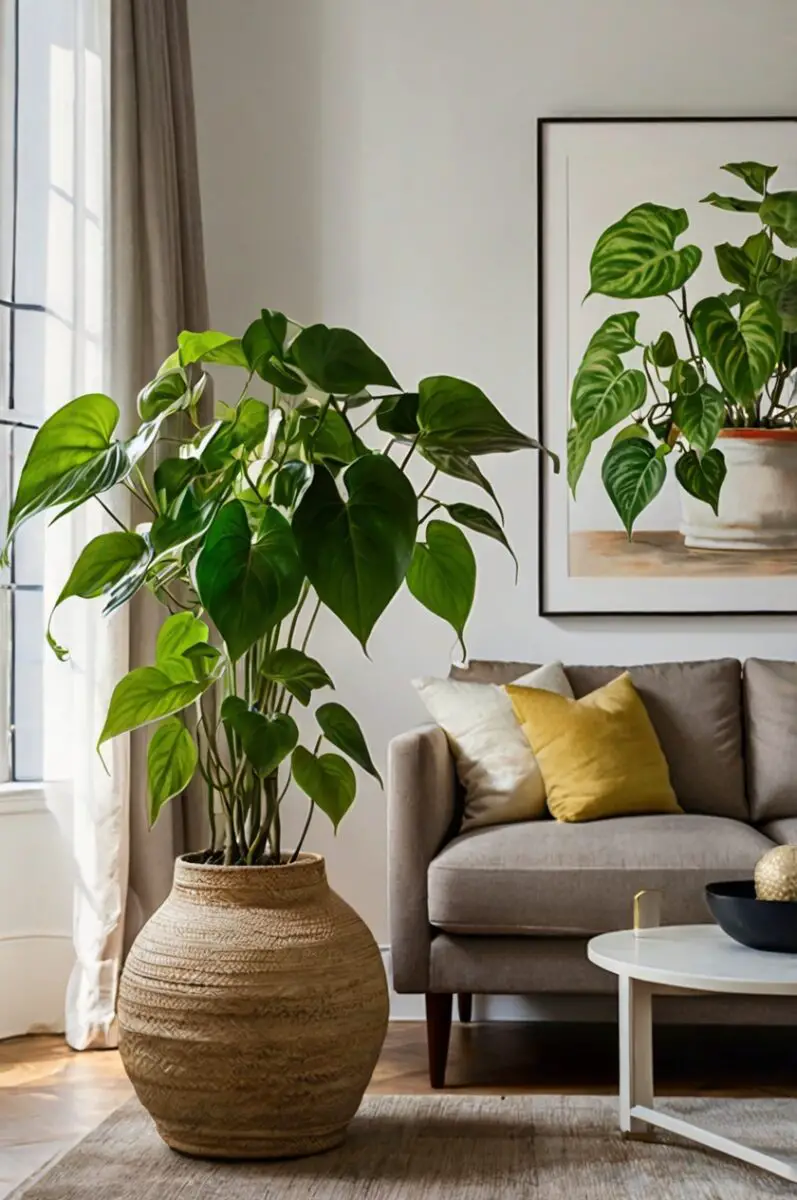
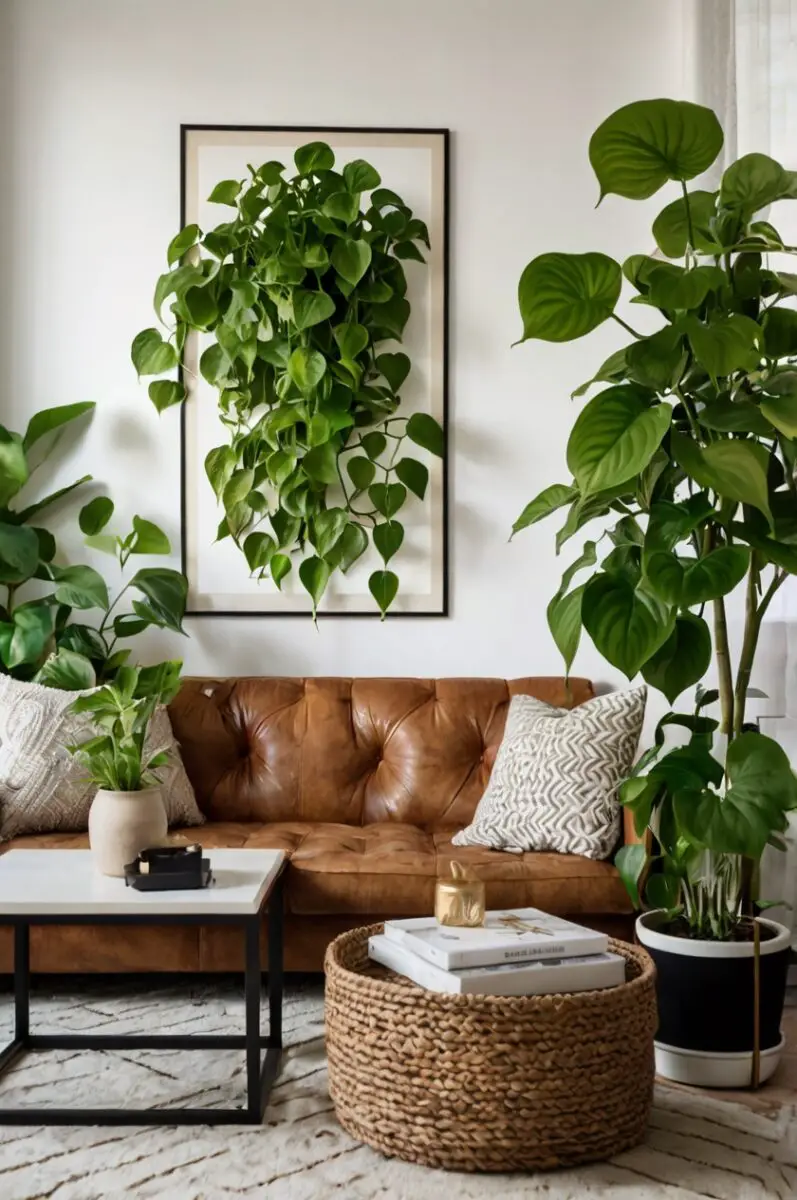
Pothos (Epipremnum aureum) plants are the versatile superstars of the low-light plant world.
These trailing beauties feature heart-shaped leaves that cascade gracefully from shelves, mantels, or hanging planters.
Available in varieties ranging from solid green to marbled patterns of white, yellow, or silver, pothos brings visual interest to any dark space.
The vining nature of pothos makes them perfect for creating living curtains or green dividers in rooms with limited natural light.
Try mounting a pothos in a wall planter above a bookshelf, allowing the vines to drape artistically across your book collection.
For a dramatic vertical display, install a series of wall hooks and guide your pothos to climb upward, creating a living wall effect without much effort.
Pothos plants can be trained around picture frames, mirrors, or window frames, adding a whimsical touch to everyday objects.
In bathrooms with limited light, a trailing pothos thrives in the humidity while adding life to an often-overlooked space.
Consider planting pothos in a hanging macramé holder positioned in the corner of a room for a boho-inspired touch that maximizes floor space.
For a modern look, place a pothos in a simple white pot on a floating shelf, allowing the vines to cascade down the wall like living art.
Pothos plants are incredibly easy to propagate – simply snip a section of vine, place it in water until roots form, then plant for an entirely new plant.
This propagation ease means you can create a cohesive look throughout your home by starting with just one plant and multiplying it for different spaces.
The versatile nature of pothos makes them perfect for styling shelves – tuck them between books and decorative objects for an effortlessly curated look.
Madison’s Current Obsessions
13 Touches To Elevate Your Home With Boho Style4. Peace Lilies: Elegant Blooms in Dim Light
Peace lilies (Spathiphyllum) are among the few flowering plants that thrive in low light conditions.
These elegant plants feature glossy dark green leaves and distinctive white “flowers” (actually modified leaves called spathes) that stand tall above the foliage.
The contrast of pure white blooms against deep green leaves creates a sophisticated look perfect for bedrooms, living rooms, or home offices.
Peace lilies serve as excellent air purifiers, removing common household toxins while adding beautiful visual elements to dim corners.
Unlike many flowering plants that need bright light to bloom, peace lilies will produce their iconic white flowers even in low-light situations.
Place your peace lily in an elegant ceramic pot to enhance its already sophisticated appearance.
For maximum impact, position your peace lily where its white blooms can be highlighted against a dark background or wall.
Peace lilies can serve as excellent bathroom plants, thriving in the humid environment while adding a spa-like quality to the space.
Consider grouping three peace lilies of different sizes together to create a lush, layered display that makes a strong visual impact.
The graceful arching leaves of peace lilies create a fountain-like effect that adds movement and energy to static spaces.
These plants clearly show when they need water by dramatically drooping their leaves, making them perfect for those who need visual reminders to care for their plants.
Peace lilies can live for many years when properly cared for, becoming impressive specimens that serve as focal points in your home.
For a contemporary look, place your peace lily in a matte black pot that contrasts beautifully with both the green foliage and white blooms.
Madison’s Current Obsessions
Creative Southwest Rustic Decor Ideas You Can't Afford To Miss!5. Chinese Evergreen: Colorful Patterns Without Sun
Chinese evergreens (Aglaonema) are the color champions of the low-light plant world.
These stunning plants feature patterned leaves with splashes of silver, pink, red, and cream that brighten dark corners without needing much light.
The wide variety of available colors means you can find a Chinese evergreen to complement any color scheme or decorating style.
Chinese evergreens have a full, bushy growth habit that makes them excellent as standalone statement plants on coffee tables or consoles.
Their compact nature makes them perfect for smaller spaces like bedrooms or office desks where they can add life without taking up too much room.
Try placing a pink-tinged Chinese evergreen variety near a mirror to amplify its color impact in a dark space.
For a coordinated look, choose a Chinese evergreen with colors that complement your room’s accent colors – plants with pink variegation for rooms with rose or burgundy accents, for example.
Chinese evergreens grow in a rounded, symmetrical form that works beautifully in contemporary ceramic pots with clean lines.
These plants make excellent table centerpieces in dining areas with limited natural light, adding color and life without blocking sightlines during meals.
Consider creating a plant shelfie featuring Chinese evergreens of different varieties, showcasing the amazing diversity within this single plant family.
For maximum visual impact, place a colorful Chinese evergreen against a white or light neutral background to make its patterns pop.
These plants grow slowly, maintaining their perfect size and shape for long periods without frequent repotting or pruning.
Try using Chinese evergreens as living color accents that tie together your room’s color scheme in those challenging low-light areas.
Madison’s Current Obsessions
13 Stylish Rustic Home Decor Ideas For A Cozy Space6. Cast Iron Plant: Indestructible Beauty for Dark Corners
Cast iron plants (Aspidistra elatior) live up to their name with nearly indestructible nature and tolerance for deep shade.
These plants feature broad, leathery leaves that grow in an elegant, arching pattern from the base.
Their deep green, glossy foliage adds a touch of traditional elegance to any space, complementing both modern and classic decorating styles.
Cast iron plants grow slowly, maintaining their perfect size and shape for years with minimal care.
The architectural, strappy leaves create dramatic shadows when positioned near subtle lighting sources like table lamps or wall sconces.
Try placing a cast iron plant in a decorative basket with a simple liner for a casual, textural look that works beautifully in family rooms or bedrooms.
For a more formal appearance, place your cast iron plant in a classic ceramic or terracotta pot to enhance its timeless appeal.
These plants make excellent partners for antique furniture pieces, their classic form complementing traditional wood tones and styles.
Consider using cast iron plants to fill dark corners where other decorative elements might be lost in shadow.
Their ability to withstand temperature fluctuations makes them perfect for entryways or hallways where drafts might challenge more sensitive plants.
The cast iron plant’s upright growth creates vertical interest in rooms with low ceilings or limited floor space.
Try creating contrast by placing your dark green cast iron plant in a light-colored pot for a simple yet striking visual effect.
For a cohesive look throughout your home, place cast iron plants in similarly styled containers in different rooms, creating visual continuity through your plant choices.
Madison’s Current Obsessions
13 Stylish Summer Decorating Ideas for Your Space7. Prayer Plants: Movement and Color in Low Light
Prayer plants (Maranta leuconeura) bring fascinating daily movement to low-light areas with their unique leaf behavior.
These captivating plants fold their leaves upward at night like hands in prayer, then lower them again during daylight hours.
The distinctive patterned leaves feature stunning combinations of green, red, and cream markings that add visual interest to any space.
Prayer plants have a low, spreading growth habit that makes them ideal for coffee tables, side tables, or shelves where their intricate patterns can be appreciated up close.
The red veining common in many prayer plant varieties adds a pop of color that works beautifully in neutral-toned rooms needing a touch of warmth.
Try placing your prayer plant on a plant stand with legs to showcase its dramatic leaf movements and allow air circulation around the foliage.
For a modern display, group three prayer plants in simple white pots of different heights to create a dynamic arrangement that highlights their colorful patterns.
These plants appreciate humidity, making them perfect companions for bathrooms or kitchens with limited natural light.
Consider creating a terrarium featuring a prayer plant as the centerpiece, using the enclosed environment to maintain the higher humidity these plants enjoy.
Prayer plants pair beautifully with other low-light plants of contrasting forms – try combining them with upright snake plants for a study in contrasts.
Their moderate size makes them perfect for brightening up dark office corners where their unusual patterns can serve as natural stress relievers.
Try positioning a prayer plant near a reading nook where you can observe its daily leaf movements while enjoying your favorite book.
For maximum visual impact, place your prayer plant against a solid background that allows its intricate leaf patterns to stand out as a living work of art.
Madison’s Current Obsessions
Revamp Your Space: 13 Striking Black Trim Ideas That Will Transform Your Interior Design8. Philodendrons: Versatile Vines for Shadowy Spaces
Philodendrons are the versatility champions of low-light spaces, available in climbing, trailing, and upright varieties.
These adaptable plants feature heart-shaped leaves in various sizes and shades of green, some with striking variegation or reddish undersides.
Their quick growth in even poor light conditions makes them rewarding choices for beginners or those wanting to quickly fill empty spaces.
Climbing philodendrons can transform a bare wall in a dark hallway into a lush vertical garden when provided with a simple trellis or moss pole.
Trailing varieties look stunning cascading from hanging planters or high shelves, adding dynamic movement to rooms with minimal natural light.
Try training a philodendron around a decorative ladder leaning against a wall for a unique living display that maximizes vertical space.
For a dramatic effect, place a philodendron in a wall-mounted planter, allowing the vines to create a living picture frame around artwork or mirrors.
Philodendrons come in numerous varieties – collect different types to create a cohesive yet diverse plant display unified by their similar leaf shapes.
Consider using philodendrons to soften hard architectural elements like shelving units or bookcases by allowing them to trail gracefully along edges.
The fast-growing nature of philodendrons means you can quickly propagate new plants from stem cuttings to expand your collection or share with friends.
Try creating a philodendron “curtain” by hanging several plants at different heights, allowing their vines to create a living room divider in open floor plans.
For a minimalist approach, place a single climbing philodendron with a moss pole in a simple pot, allowing its natural growth pattern to serve as a sculptural element.
These adaptable plants can be trained to grow horizontally along mantels or shelves, creating living garlands that bring life to static displays.
Madison’s Current Obsessions
13 Creative Locker Ideas to Elevate Your Space9. Spider Plants: Arching Elegance for Dark Corners
Spider plants (Chlorophytum comosum) feature gracefully arching leaves that cascade from the center in a fountain-like display.
These cheerful plants come in solid green or variegated varieties with white or yellow stripes that seem to glow in low-light conditions.
Their dramatic arching form creates visual movement, making them perfect for breaking up straight lines in modern interiors.
Spider plants continually produce tiny plantlets on long stems, creating a dynamic, ever-changing display that adds interest to static spaces.
These baby plants hanging from the mother plant create a unique decorative element unlike any other houseplant.
Try suspending a spider plant in a simple hanging planter, allowing the plantlets to dangle freely in the air like a living mobile.
For a playful touch, place your spider plant on a high shelf where its babies can cascade downward, creating a waterfall effect of miniature plants.
Spider plants look stunning in macramé hangers, the woven texture of the hanger complementing the linear pattern of the leaves.
Consider placing a spider plant on a plant stand near a staircase, allowing its arching form to echo the movement of the stairs.
The numerous baby plants can be easily propagated by pressing them into soil while still attached to the mother plant, then cutting the connecting stem once rooted.
This propagation ease makes spider plants perfect for creating a cohesive look throughout your home without purchasing multiple plants.
Try using a row of spider plants along a dark hallway, placing them on wall-mounted shelves where their cascading form can be fully appreciated.
For a modern look, place a variegated spider plant in a simple black pot, allowing the striking contrast between the dark container and light-striped leaves to create visual drama.
Madison’s Current Obsessions
13 Modern Victorian Decor Ideas for a Chic Twist10. Dracaena: Sculptural Statements for Low-Light Areas
Dracaena plants bring dramatic, tree-like structure to low-light areas with their woody stems and fountain-like leaf clusters.
Available in many varieties including corn plant, dragon tree, and lucky bamboo, dracaenas offer diverse options for different spaces and styles.
Their upright growth creates instant height in rooms with low ceilings, adding vertical interest without taking up much floor space.
Many dracaena varieties feature striking variegation patterns with cream, yellow, or red edges that brighten dark corners effortlessly.
These statuesque plants can serve as living sculptures, their distinctive silhouettes creating dramatic shadows when subtly lit from below.
Try placing a tall dracaena in a woven basket next to a sofa or reading chair to create a cozy nook in a dim corner.
For maximum impact, position a large corn plant (Dracaena fragrans) in an empty corner where its height can draw the eye upward and fill otherwise unused space.
Dracaenas with colorful leaf edges, like the rainbow plant (Dracaena marginata colorama), add subtle color to neutral room schemes without overwhelming the space.
Consider grouping different dracaena varieties together to create a low-light container garden showcasing their diverse leaf patterns and growth habits.
These plants make excellent room dividers in open floor plans, their tall, slender profiles creating subtle boundaries without blocking light or views.
Try placing a dracaena near a television or computer area where its air-purifying qualities can help combat electromagnetic pollution.
For a contemporary look, place your dracaena in a simple concrete or metallic planter that contrasts with its organic form.
The architectural quality of dracaenas makes them excellent companions for modern furniture with clean lines and minimal ornamentation.
Madison’s Current Obsessions
These Dark Goth Apartments Feel Impossible To Ignore11. Ferns: Lacy Texture for Dim Environments
Ferns bring unmatched delicate texture to low-light spaces with their feathery fronds and lush growth habit.
Boston ferns, bird’s nest ferns, and maidenhair ferns all thrive in the shadowy conditions that challenge many other houseplants.
The intricate leaf patterns create visual interest through texture rather than color, adding depth and complexity to monochromatic spaces.
Ferns have a naturally romantic, slightly wild quality that softens rigid architectural elements and hard surfaces in modern homes.
Their lush, overflowing growth habit makes them perfect for breaking up straight lines and adding organic movement to structured spaces.
Try hanging a Boston fern in a bathroom with limited natural light, where the humidity will help it thrive while its cascading form adds spa-like luxury.
For a dramatic statement, place a large floor fern in a decorative pot next to a fireplace or dark corner, allowing its delicate fronds to contrast with solid surfaces.
Ferns pair beautifully with vintage or antique elements, their timeless appearance complementing traditional decor styles.
Consider placing a bird’s nest fern on a dark bookshelf, its smooth, rippled leaves providing contrast to the linear book spines.
The natural green tones of ferns create a calming atmosphere in bedrooms or meditation spaces with limited light.
Try creating a fern terrarium for coffee tables or side tables, using the enclosed environment to maintain the higher humidity these plants prefer.
For a cohesive grouping, collect different fern varieties and display them together to showcase their diverse textures and growth habits.
The gentle movement of fern fronds in slight air currents adds a dynamic, living element to otherwise still spaces with limited natural light.
Madison’s Current Obsessions
13 Colors That Give Your Home Instant Luxury12. English Ivy: Classic Climber for Dark Corners
English ivy (Hedera helix) brings traditional elegance to low-light spaces with its distinctive lobed leaves and trailing vines.
This versatile plant can be trained to climb trellises, cascade from shelves, or grow densely in pots for a full, lush appearance.
The variegated varieties with white or yellow patterns brighten dark corners while adding refined texture to any space.
English ivy has strong visual associations with historic architecture, bringing a touch of timeless elegance to contemporary spaces.
Its adaptable growth habit means you can shape and train ivy to fit your specific decorative needs, from formal topiary forms to casual cascades.
Try creating a living picture frame by planting ivy in a shallow container with a simple frame attached, allowing the vines to fill the frame over time.
For a traditional look, place ivy in a classic urn or pedestal planter, training the vines to cascade gracefully over the edges.
English ivy pairs beautifully with brass or copper accents, the metallic surfaces reflecting light onto the ivy’s glossy leaves.
Consider using ivy to soften the lines of bookcases or shelving units by allowing it to trail naturally along edges and between objects.
The strong vertical growth of ivy can be harnessed to create living columns on plain walls in dim hallways or transitional spaces.
Try incorporating ivy into seasonal decorating by weaving temporary strands through mantels or stair railings for special occasions.
For a formal look, place matching ivy topiaries on either side of a fireplace or entryway, creating balanced symmetry in low-light areas.
The distinguished appearance of English ivy brings a touch of countryside manor elegance to urban apartments and modern homes.
Madison’s Current Obsessions
9+ Upcycling Ideas and Thrift Store Makeovers for Spring Décor and Easter Decorations13. Rubber Plants: Bold Leaves for Dramatic Impact
Rubber plants (Ficus elastica) make powerful statements in low-light areas with their large, glossy leaves and strong silhouettes.
These impressive plants feature broad, oval leaves in deep green, burgundy, or variegated patterns that create instant visual impact.
Their upright growth and substantial presence make them perfect for filling empty corners or serving as focal points in dimly lit rooms.
Rubber plants come in varieties with different colored leaves – from the classic dark green to the dramatic almost-black ‘Burgundy’ to variegated types with cream or pink markings.
Their thick, leathery leaves have a luxurious, almost artificial appearance that adds a touch of opulence to any space.
Try placing a tall rubber plant next to a sofa or reading chair to create an instant cozy nook in a room with limited natural light.
For maximum drama, position a burgundy variety against a light-colored wall where its deep, rich color creates striking contrast.
Rubber plants have a naturally architectural quality that pairs beautifully with mid-century modern furniture and decor.
Consider placing your rubber plant on a wooden plant stand to elevate it both literally and visually within your space.
The large, reflective leaves bounce what little light is available around the room, helping brighten dark corners naturally.
Try grouping a rubber plant with smaller low-light plants of contrasting texture, using the rubber plant’s bold leaves as a backdrop for more delicate specimens.
For a contemporary look, place your rubber plant in a simple, cylindrical pot in a contrasting color to its leaves – white for dark varieties or black for variegated types.
The striking silhouette of a rubber plant creates dramatic shadows when positioned near subtle accent lighting, adding depth and dimension to dim spaces.


